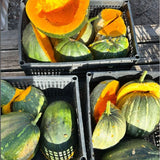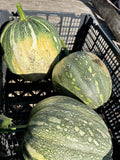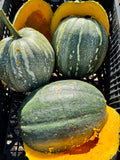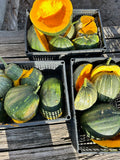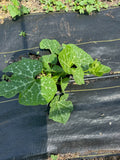Jamaican Pumpkin
Cucurbita moschata
Tropical pumpkins have been an important part of Caribbean cuisine for thousands of years, and are known for their Pumpkin Rundowns and Pumpkin Punches in Jamaica, Soup Joumou in Haiti, Pumpkin Talkari in Trinidad, and countless Calabaza dishes in Puerto Rico and beyond. This particular Jamaican Pumpkin is a diverse population with sweet, beautiful orange flesh and a dark green skin with light green streaks. It comes from our friend Marlene Wilks, originally from Jamaica, who grows traditional Caribbean crops in East New York, Brooklyn. She cuts her pumpkin and puts it in a steamer for 5 or 10 minutes until it's soft and sweet, and she says it is also great for soups.
This seed was grown with love and care by Bitter Kalli of Star Apple Nursery, who grows Jamaican and Filipino crops for our catalog and for their community.
Also known as West Indian Pumpkin, Calabaza.
Days to maturity: 85-105
Seeds per pack: 25
Germination rate: 89% on 04/01/2025
Planting / harvesting notes
Direct sow in warm soil after the last frost, or seed indoors 2-3 weeks beforehand and transplant. Plant 3 seeds per hill spaced several feet apart, or seed in rows, one plant every 2-3 feet. Allow vines space to sprawl. If grown in corn, you may need to train them so they won't pull it down! Avoid downy mildew by watering only at the base of the plant (not on the leaves!). Harvest when the stem begins to turn brown and woody and the fruit becomes hard, leaving a couple/few inches of stem. Cure in a dry or sunny place for a week, and then store in a cool (45-50 degrees) room for up to 5 months (however, keep an eye on it and use it at earliest sign of softening if not before).
Seed keeping notes
Squash is insect pollinated and requires about 1/2 a mile of isolation from other varieties of the same species, which in this case is C. moschata. The seeds will be fully mature on any squash when the stem of the fruit has turned brown and woody, so when you eat your squash (after some weeks or months of curing, see above), the seeds should also be ready for harvest. Separate the seeds from the flesh, rinse them, and dry them on a screen or paper product away from direct sunlight in a ventilated place. The plumpest and hardest seeds will be most viable.








